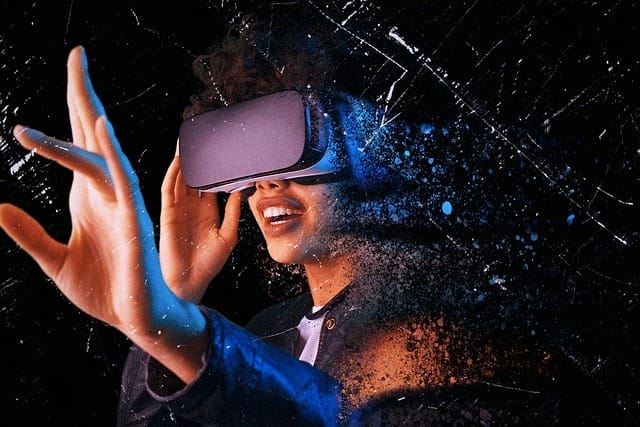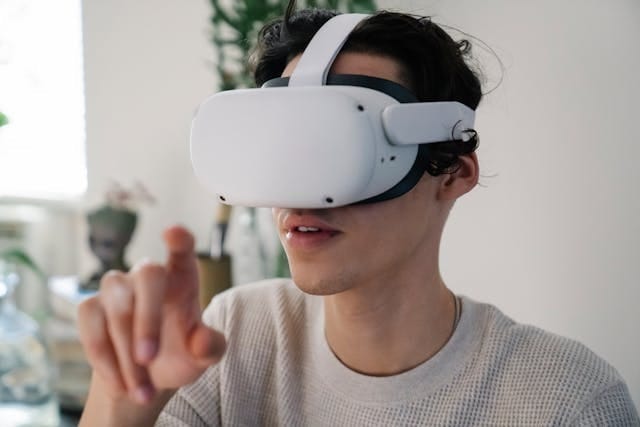Mixed Reality Statistics: Market Insights, Trends & Growth
Mixed Reality (MR) is a fast-growing technology blending the physical and digital worlds. From immersive gaming to enterprise training and healthcare, MR is reshaping how we interact with information, products, and people. To understand its real impact, let’s review numbers that validate its adoption, highlight opportunities, and reveal where the market is headed.
In this blog, we will cover the key Mixed Reality statistics and facts you need to know, including market size, application trends, regional growth, user adoption, and future outlook.
Global Mixed Reality Market Overview and Growth
The global Mixed Reality market has experienced rapid expansion in recent years. According to Grand View Research, the market was valued at USD 5.03 billion in 2023 and is expected to reach USD 8.7 billion by 2025. This growth trajectory is projected to continue, with a compound annual growth rate (CAGR) of 34.8%, reaching an estimated USD 40.5 billion by 2030.
The rapid expansion is fueled by growing adoption of immersive technologies, significant improvements in hardware, and the increasing integration of Mixed Reality solutions in sectors like advertising, education, manufacturing, construction, healthcare, and retail.
Mixed Reality Market by Technology
The Mixed Reality market is evolving with the help of various technologies that enhance user interaction, spatial awareness, and real-time responsiveness. Here is a breakdown of how different technologies are influencing the market landscape.
Hardware vs Software vs Services
In many reports, hardware leads in revenue share because headsets and sensors are expensive initial investments. As of 2024, the hardware accounts for ~64.52% of the Mixed Reality market share.
Software (platforms, content, SDKs) and services (maintenance, cloud, support) tend to grow faster, even from a smaller base. In 2024, the Mixed Reality software market in North America generated about USD 890 million.
MRaaS models (cloud-based Mixed Reality delivery) are emerging, letting you subscribe rather than purchase outright. Services are forecast to grow with a CAGR of ~46.43% through 2030.
Device Types
Head-Mounted Displays (HMDs)
Head-mounted displays, including tethered and standalone headsets, hold the largest share of the global Mixed Reality market size. In 2024, they accounted for over 52% of MR hardware revenue, driven by enterprise training, gaming, and healthcare simulation. Standalone headsets are expanding fastest, with a projected CAGR of ~46.09% through 2030.

Smartglasses
Smartglasses are gaining momentum in industrial design, logistics, and remote assistance. The global smart glass market was valued at about USD 6.9 billion in 2024 and is projected to reach around USD 16.0 billion by 2033. This implies a CAGR of about 9-10% for 2025-2033.
Handheld Devices
Tablets and smartphones used for MR applications form the handheld device segment. While they don't deliver fully immersive MR, their affordability and accessibility drive mass adoption. Handheld MR applications are projected to reach USD 4–5 billion in revenue by 2030, especially in retail, education, and marketing campaigns.
Projection-Based Displays
Projection-based Mixed Reality is a niche but innovative category, used for collaborative design, training simulators, and immersive retail experiences. In 2024, the projection mapping market was estimated at around USD 4.00 billion, and is projected to grow to USD 21.45 billion by 2032, with a CAGR of ~23.36%.
Mixed Reality Market Share – By Application Statistics
Beyond hardware and technology, the true impact of Mixed Reality is best understood by evaluating how different industries are adopting it across practical applications.
According to Market Research Future, gaming held a dominant share in 2023, about USD 4.52 billion, and is projected to reach USD 35 billion by 2032.
That same report shows healthcare at USD 2.74 billion in 2023, growing toward ~USD 20 billion by 2032 (used for surgical planning and training).
Education was ~USD 1.94 billion in 2023, rising to ~USD 15 billion by 2032 (immersive learning, labs).
Retail/e-commerce and real estate also show solid growth. Retail market share was ~USD 2.92 billion in 2023; real estate ~USD 1.8 billion.
In a narrower MR-focused report, training & simulation claims ~34.7% of the MR market revenue in 2024, with healthcare showing the fastest growth with around 45.67% CAGR by 2030.
Mixed Reality Statistics By User Base of the AR and VR Software Market
To understand Mixed Reality users, you must also encompass AR/VR user base statistics:
According to Statista, 98 million people used VR hardware in 2023, while 23 million experimented with advanced AR devices.
Because MR often blends AR and VR, its potential user base overlaps with both AR and VR populations.
Mordor reports that AR held ~43.7% of the combined market of AR, VR, and MR in 2024, while MR is on a steeper growth trajectory (~34.2% CAGR) toward 2030.
In the MR-specific context, adoption is stronger in enterprise settings (training, design, remote assistance) than consumer use today.
Mixed Reality Market Summary
The global Mixed Reality market size is growing explosively, from billions today to tens or even hundreds of billions in forecasts.
Hardware currently dominates revenue share, but software and services are growing at faster rates.
Gaming and entertainment is the dominant sector with the largest share, while training, simulation, and healthcare show the fastest growth.
User base is strongest in enterprise and industrial use cases; consumer MR usage is still emerging.
You see overlapping statistics from AR and VR markets, but MR is carving its own niche.
Mixed Reality Trends by Region
While global adoption of Mixed Reality is accelerating, regional trends highlight distinct growth drivers shaped by local industries, investments, and consumer demand.
U.S. Mixed Reality Market Trends
The U.S. Mixed Reality headset market was valued at USD 1.03 billion in 2023.
It's projected to grow at a CAGR of 26.6% from 2024 to 2030, reaching USD 5.35 billion by 2030.
Hardware dominated 2023 U.S. MR headsets with ~72.4% share.
Enterprise demand in training, remote work, and immersive meetings drives much U.S. MR adoption.
Europe Mixed Reality Market Trends
The Europe Mixed Reality market is projected to grow at a compound annual growth rate (CAGR) of 50.4% over 2024–2031.
Germany currently dominates the European MR market and is expected to reach ~$9.31 billion by 2031.
In the MR gaming segment, Europe is estimated to hold ~29% of the global revenue share, with growth in the European MR gaming market expected at ~34.4% CAGR between 2025 and 2033.
Asia Pacific Mixed Reality Market Trends
The Asia Pacific Mixed Reality headset market was valued at USD 1,343.4 million in 2023 and is projected to grow to USD 9,010.4 million by 2030, with a CAGR of 31.2% during 2024‑2030.
The broader Asia Pacific Mixed Reality market (hardware and software, etc.) is expected to grow at a CAGR of ~51.7% between 2024 and 2031.
In 2024, the Asia Pacific held around USD 977.78 million of Mixed Reality market revenue (≈ 23% of the global Mixed Reality revenue) and is forecasted to surge to over USD 41,100 million by 2031, driven by strong growth in China, India, Japan, South Korea, and Southeast Asia.
Mixed Reality Trends & Projections
As the market matures and technology evolves, the Mixed Reality future outlook is increasingly promising.

The global Mixed Reality market is projected to exceed $40.5 billion by 2030, growing at a CAGR of 34.8%.
Growth is driven by faster 5G adoption, cloud rendering, and AI-powered MR engines that reduce latency and improve realism.
Enterprise adoption, particularly in training, simulation, field service, and healthcare, is expected to accelerate.
Consumer applications like gaming and immersive media will still dominate in terms of visibility, but enterprises will provide more consistent revenue.
By region, Asia Pacific is expected to outpace other markets due to manufacturing hubs, while North America leads in platform development and enterprise integration.
In other words, MR is not just a trend; it's becoming a key element of digital transformation strategies worldwide.
How Can Flam Leverage MR Statistics?
Using MR statistics, Flam can show how immersive experiences help businesses increase customer attention, boost conversion, improve campaign performance, and expand brand reach.
Benchmark Performance Against Market Growth
We track and benchmark our campaign performance against global Mixed Reality statistics to ensure we're always ahead of industry standards. From serving millions of immersive renders to analyzing average session durations, our metrics reflect both engagement quality and scale. These benchmarks allow us to measure ROI for clients with precision and transparency.
Embed Real-Time Dashboards
Our AI-driven dashboards provide real-time visualizations of Mixed Reality usage, helping brands see how audiences interact with campaigns across devices and regions. By embedding live MR usage metrics, we turn complex data into actionable insights, empowering marketers to make fast, informed decisions.
Positioning as a Scalable Platform
With its AI-first Mixed Reality platform, Flam helps brands publish immersive experiences at scale. Our low-latency rendering engines ensure that users enjoy seamless Mixed Reality campaigns, while our adaptive AI optimizes for engagement across industries, from retail and real estate to entertainment and education.
Targeting by Region and Industry
Flam harnesses regional and industry-level Mixed Reality statistics to identify high-growth segments for brands and enterprises. Whether it's tapping into the rapidly expanding Asia-Pacific market or refining campaigns for U.S. enterprise adoption, our data-backed approach ensures that brands invest where the impact is most significant.
Conclusion: The Future of Mixed Reality
The rise of Mixed Reality marks a powerful shift in how humans engage with technology. With the U.S. market growing at over 26.6% CAGR and Asia-Pacific projected to exceed USD 9 billion by 2030, MR is moving beyond novelty into necessity. As industries embrace immersive collaboration, realistic training, and interactive design, Mixed Reality stands at the forefront of a connected, intelligent future.